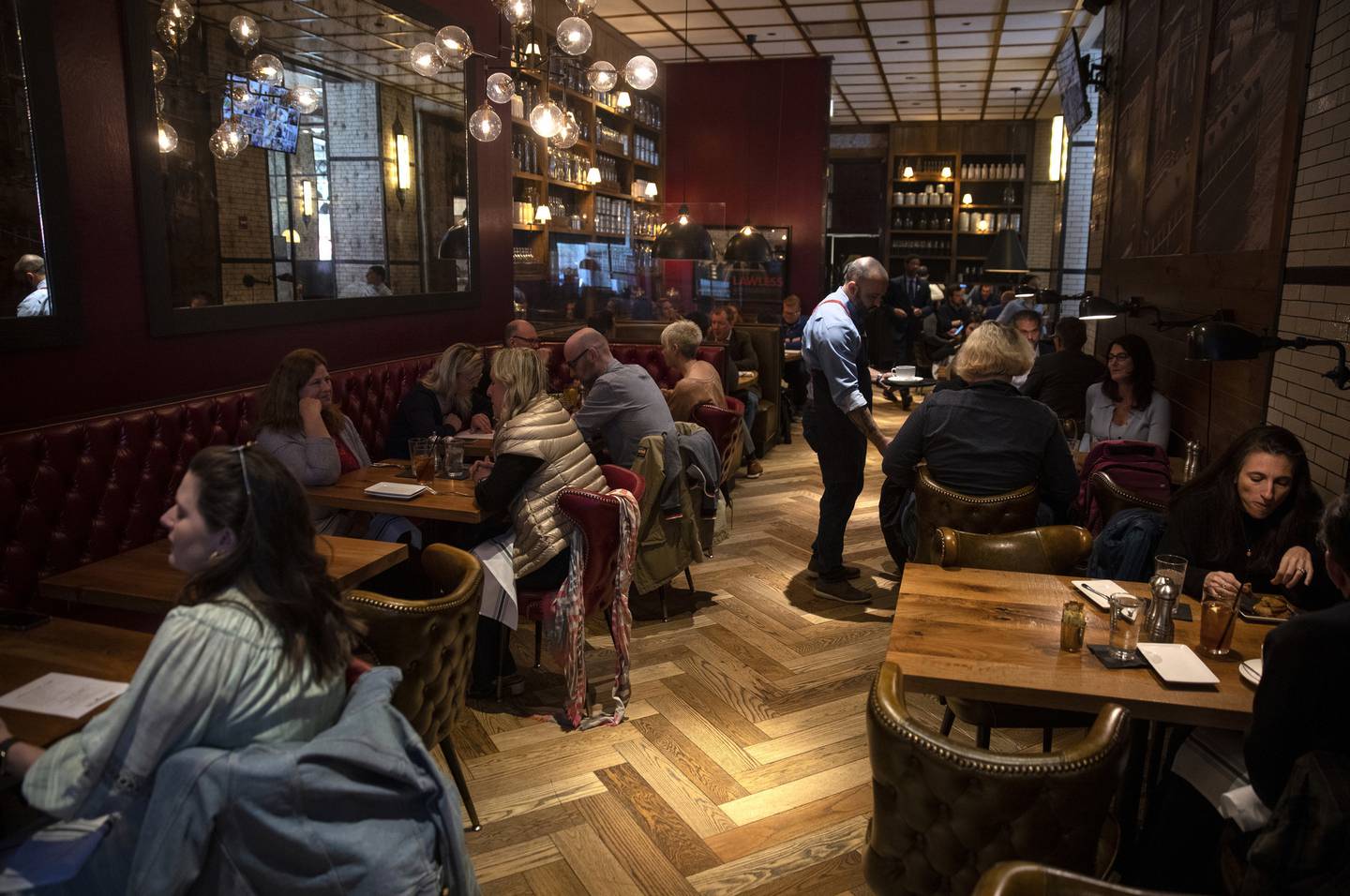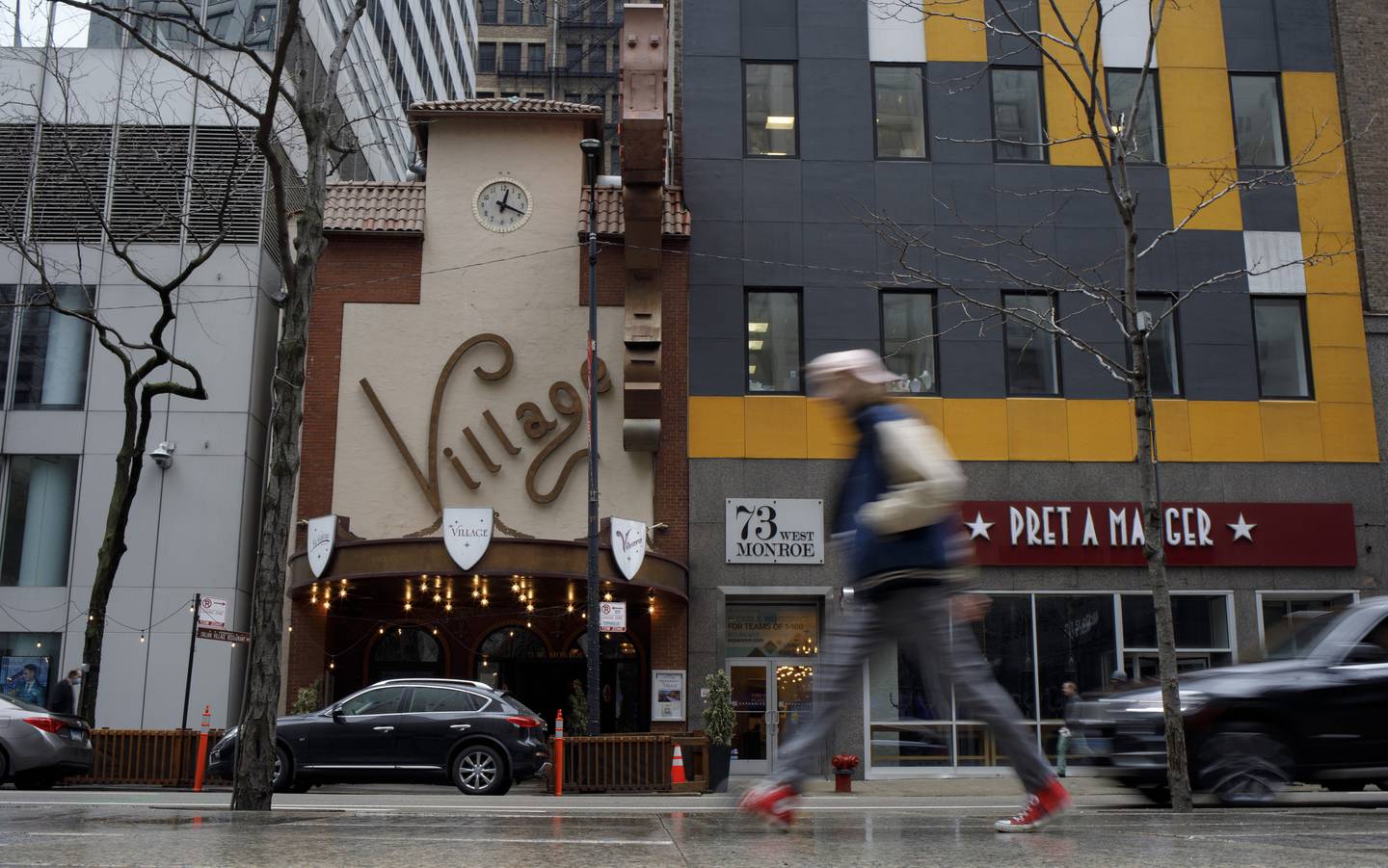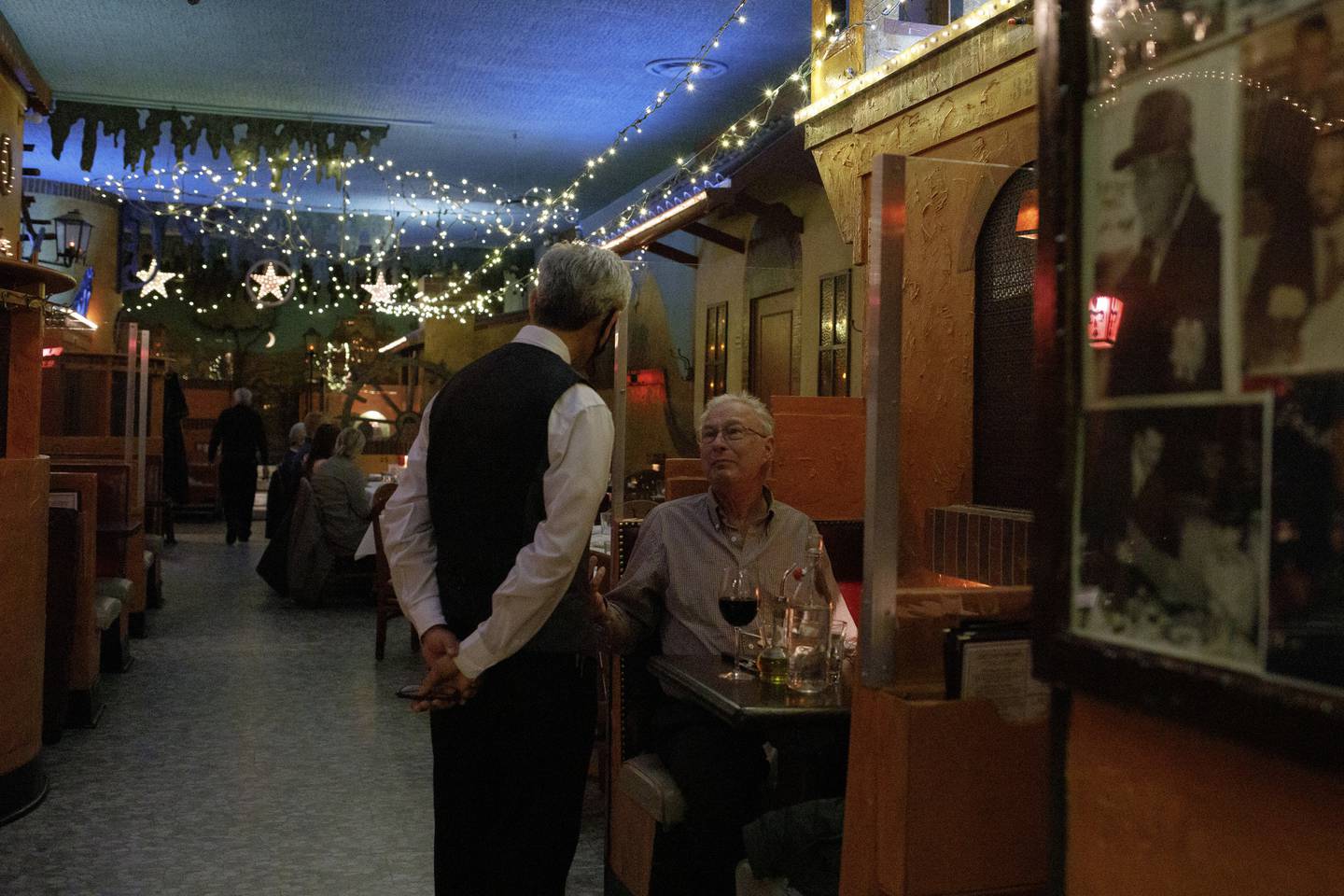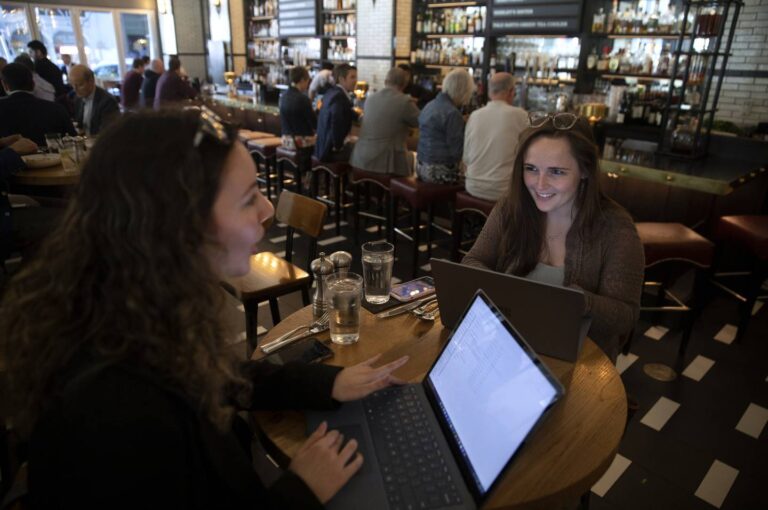Chicago’s downtown almost looks normal some days, especially during the middle of the week when office workers pack themselves onto trains and the streets bustle with pedestrians. But downtown restaurant owners say they see something different when tallying weekly sales.
Even the busiest lunch hours rarely hit pre-pandemic levels, and Mondays and Fridays are even worse.
Advertisement
“We’re questioning whether it even makes sense to be open on these days,” said Scott Weiner, co-owner of Fifty/50 Restaurant Group, which operates more than a dozen establishments across Chicago, including West Town Bakery and 90th Meridian, both on LaSalle Street in the financial district.
And with many downtown firms planning to bring back their employees for just two or three days a week, restaurants could permanently lose several days of lunchtime business. That would be another heavy blow to an industry buffeted for two years by shutdowns, rising food prices and labor shortages, perhaps putting off real recovery for years.
Advertisement
It’s not just a problem for restaurant owners. The health of the local restaurant scene will play a key role in determining the vibrancy of downtown as it emerges from the pandemic.
Downtown Chicago provides a greater variety of food options than any suburb or city neighborhood, from places to grab a quick sandwich to pricey establishments where businesses entertain out-of-town clients. Like Millennium Park or the lakefront, restaurants make downtown appealing. But if the industry continues to suffer, restaurant owners may decide it’s not worth it to reopen the many locations closed during the pandemic. Some say landlords may eventually have to agree to lower rental payments if they want to keep the restaurant scene healthy.
On Wednesdays, hungry theatergoers attending afternoon matinees crowd into The Dearborn, a 225-seat restaurant at 145 N. Dearborn St., according to proprietor Clodagh Lawless. But it’s a different story on other days.
“Wednesdays are just a delight,” she said. “Everything about Wednesday is perfect, but our Friday lunch is now very quiet, and that’s a problem, because we had a business model when we signed a lease which relied on a five-day workweek from our business clientele.”
“The Loop is still in dire straits,” Weiner said. “We need the city and the people who call the shots at big companies to get people back to the office.”
Weiner estimates lunchtime business is down between 60% and 70% on Mondays and Fridays, and on the other weekdays it’s down about 20%.
The lingering uncertainty helps make it difficult to justify reopening Fifty/50 Restaurant Group’s Steadfast at The Gray, a Central Loop restaurant at 120 West Monroe St., in the same building as the Kimpton Gray Hotel. It was shuttered during the pandemic as business travel dried up and hotel occupancy plunged.
Average hotel occupancy in downtown Chicago was 59% for the week ending April 9, according to hospitality data firm STR. It was 89.1% for the comparable week in April 2019.
Advertisement
“We’re not in any hurry to reopen Steadfast,” Weiner said.
Lawless, who runs The Dearborn in partnership with her sister Amy Lawless, said they’ve survived the two years of turmoil brought on by COVID-19, and are determined to meet whatever challenges remain. She learned the business while growing up in Ireland from her parents, who ran restaurants and a small hotel, and switching careers isn’t an option.
“It’s in our blood,” she said. “We know nothing else, but the restaurant industry, which I adore, right now is a bleak landscape.”

The pandemic squeeze may hit restaurants, which typically have small profit margins, harder than other businesses, according to Sam Toia, president and CEO of the Illinois Restaurant Association, an industry lobbying group.
“Between 95 and 97 cents of every dollar goes toward labor costs, produce costs and fixed costs, Toia said. “And that’s in the good times.”
Some downtown landlords have been willing to cut deals with restaurants during the crisis, allowing them to pay reduced rent while business was slow, he added.
Advertisement
Weiner said if hybrid work schedules remain in place and restaurants can’t generate the revenue they once did, he’s optimistic landlords will negotiate the deals needed to keep these key businesses afloat, perhaps including lower rental rates.
“The smart landlords are going to figure out ways to keep the restaurants in their buildings open, because if they don’t, they could lose their (office) tenants,” Weiner said.
It’s not just upscale restaurants feeling the pinch. Fast-food operators have also noticed slowdowns.
“Pre-pandemic Mondays and Fridays were softer days for us, averaging slightly lower than our Tuesday-Thursday business,” Potbelly Sandwich Shop COO Adam Noyes told the Tribune in a statement. “That gap has become a bit more pronounced in 2022, likely due to the hybrid office policies.”
“We believe that these market condition pressures should definitely be considered by landlords to ensure that shops are able to be profitable,” he added. “We have found a number of landlords to be accommodating in supporting us through this recovery.”
Michael Klein, managing principal of Glenstar, which owns the Chicago Board of Trade Building downtown, home of Ceres Café, said he agreed that if downtown businesses stick with short workweeks long term, restaurants will suffer. But he also cautions that the recovery is in its early stages, and office workers may still flood back downtown in the coming months.
Advertisement
“If we get to the point where 50% of the people are coming back to work, others may start to feel that they’re missing out on something, perhaps not getting that plum assignment,” Klein said.
It’s difficult to measure in real time exactly how many downtown workers have returned. According to Kastle Systems, a security firm that tracks office entries, office occupancy in the Chicago metro area stood at 37.8% the week of April 13, the same as the week before, but the company doesn’t provide a separate breakout for the central business district.
Klein added that tourists have returned in greater numbers than office workers, so restaurants near tourist-heavy areas like Michigan Avenue or Willis Tower should recover faster.
“If you’re across from the Art Institute and go into Chick-fil-A, it may already feel normal because it’s filled up at lunchtime, but two or three blocks away in the Central Loop, restaurants are much quieter,” Klein said. “So, when people do come back, there are going to be discussions about what restaurant rents should be, but they’re going to be block by block, location by location decisions.”
Weiner said he believes the old real estate adage, “location, location, location,” will be even more important to the downtown restaurant sector. Even though Fifty/50 Restaurant Group is keeping Steadfast closed for now, it’s already confident enough in the Chicago market to launch later this year one of its biggest projects yet, a two-story restaurant in Willis Tower called Kindling.
Starting this fall, the 16,000-square-foot location’s chef will serve diners food cooked in a wood-fire rotisserie oven. Weiner said he expects many of the customers will be out-of-towners.
Advertisement
“Willis Tower is one of the top tourist destinations in Illinois, let alone Chicago, so it’s a totally different business model,” he said.
Some Loop restaurants have advantages that should keep business humming no matter what happens.
Gina Capitanini’s family has owned Italian Village Restaurants since 1927, a brand name that keeps customers returning to the landmark The Village at 71 W. Monroe St. Like The Dearborn, it also draws big crowds of theatergoers. Unlike most of their competitors, the family owns the property, thereby avoiding the astronomically high rents of downtown.
“It’s a lot better than it was six months ago, so we’re surviving and even doing better than I expected at this point,” Capitanini said.

The week before Easter was particularly rewarding.
“I probably had two or three of the best days that I’ve had in the past two years,” she said. “I probably need more new employees than I need new customers.”
Advertisement
But the pandemic did force Capitanini to close both La Cantina and Vivere, the two other restaurants in the building. She currently has no plans to reopen either.
Toia said more restaurants could go under even as more employees return to their workplaces unless Congress replenishes the Restaurant Revitalization Fund. The fund’s $28.6 billion in initial funding ran out last summer as thousands of restaurants nationwide rushed to secure relief.
The House of Representatives approved this month $42 billion in grants for food service businesses, but according to an April 21 report in Roll Call, an aid package in the Senate faces headwinds after attracting little Republican support.
About 177,000 restaurants were approved for grants through the Restaurant Revitalization Fund in 2021 but did not receive any funds, according to the National Restaurant Association.

The Dearborn was one of the unlucky ones, Lawless said. She and her sister spent the past two years without help, paying rent and enduring several shutdowns, as well as the rising costs for food and labor.
“In January, when omicron began surging, it was desolate downtown,” Lawless said. “I mean, it was literally tumbleweeds. So, our choice was, do we open for January and February and lose a ton of money, or stay closed and lose a ton of money? We chose to open so we could keep our team together.”
Advertisement
If Congress does replenish the relief fund, Lawless said The Dearborn could use the money to stock up on supplies and avoid any future supply chain disruptions, pay staff more, or perhaps give the restaurant’s interior a face-lift.
No matter what happens with that legislation, Lawless said she sees hopeful signs. A full slate of conventions has returned to McCormick Place for 2022, and even though attendance so far is still significantly lower than 2019, groups attending these events are already making reservations weeks in advance.
“Before this, our margins were tight, and now it’s even tougher,” she said. “But there’s definitely light at the end of the tunnel, the only question is, how long is this tunnel?”






